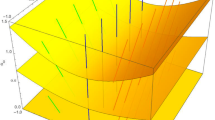Summary
Hamilton’s principle is applied to an invariant integral in which the field variables, regarded as independent, are the coefficients Γμν α defining a symmetric affine connection, the metric tensorg μνand the electromagnetic four-vectorx μ. Variation of the Γμν α yields an expression for the Γμν α in terms ofg μνandx μVariations with respect to thex μand theg μνlead respectively to the field equations\(\begin{gathered} F^{\mu \nu } _{i\nu } \hfill \\ G_{\mu \nu } - \frac{1}{2}g_{\mu \nu } G + \lambda g_{\mu \nu } = B\left( {F_{\mu \alpha } F_\nu ^\alpha - \frac{1}{4}g_{\mu \nu } F_{\alpha \beta } F^{\alpha \beta } } \right) \hfill \\ \end{gathered} \)% MathType!End!2!1! whereB is a constant which experience requires to be positive,\(F_{\mu \nu } = \frac{{\partial _{\kappa _\mu } }}{{\partial _{x_\mu } }} - \frac{{\partial _{\kappa \nu } }}{{\partial _{x_\mu } }}\)% MathType!End!2!1! and a semi-colon denotes covariant differentiation.
Riassunto
Si applioa il principio di Hamilton ad un integrale invariante in cui le variabili di campo, considerate indipendenti, sono i coefflcienti Γμν α che definiscono una connessione simmetrica affine, il tensore metricog μνe il quadrivettore elettromagneticox μ. Una variazione dei Γμν α dà un’espressione dei Γμν α in funzione dig μνex μ. Le variazioni rispetto ax μe ag μνportano rispettivamente alle equazioni di eampo\(\begin{gathered} F^{\mu \nu } _{i\nu } \hfill \\ G_{\mu \nu } - \frac{1}{2}g_{\mu \nu } G + \lambda g_{\mu \nu } = B\left( {F_{\mu \alpha } F_\nu ^\alpha - \frac{1}{4}g_{\mu \nu } F_{\alpha \beta } F^{\alpha \beta } } \right) \hfill \\ \end{gathered} \)% MathType!End!2!1! in cuiB è una costante che l’esperienza richiede sia positiva,\(F_{\mu \nu } = \frac{{\partial _{\kappa _\mu } }}{{\partial _{x_\mu } }} - \frac{{\partial _{\kappa \nu } }}{{\partial _{x_\mu } }}\)% MathType!End!2!1! ed il punto e virgola indica la differenziazione covariante.
Similar content being viewed by others
References
A. S. Eddington:Mathematical Theory of Relativity, 2nd edition (Cambridge, 1924).
W. Pauli:Theory of Relativity (translated byG. Field) (London, 1958).
Author information
Authors and Affiliations
Rights and permissions
About this article
Cite this article
Clark, G.L. An action principle in general relativity. Nuovo Cim 26, 637–651 (1962). https://doi.org/10.1007/BF02781793
Received:
Published:
Issue Date:
DOI: https://doi.org/10.1007/BF02781793




